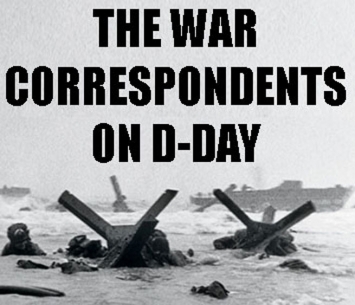
The battle of the hedgerows as experienced by the paratroopers of the 82nd Airborne Division: "They all had been fighting since D-Day. Compared with the obstacles at the beginning of their drive, the hill they had just taken was only a minor deal, but it was no push-over. "At some places," one paratrooper told me, "the fighting was so close the Krauts didn't even bother to throw their grenades, they just handed them over to us." D-Day for the lads of the U.S. Army Air Corps' Eighth Air Force was a time of great excitement and anticipation. Despite the exhaustion that comes with a fifteen hour day, all concerned recognized well that they were participating in an historic event that would be discussed long after they had left this world, but of greater importance was their understanding that the tides of war were shifting in the Allies' favor.
In his book Wartime, Paul Fussel noted that the Allies had placed as many as 11,000 planes in the skies above France that day.
Click here to read about the 8th Air Force and their bombing efforts in the skies above Germany. An eye-witness account of the U.S. Army Ninth Air Force A-20 bombers as they made their runs on D-Day: "There was no time to lose on this mission. Hitler's armies might well be driving over those crossroads toward the beachheads at this minute. This was not just an ordinary mission. It was the beginning of a mission that some day might end all combat missions."
"'There's London.' Rafalow announced, over the intercom."
"I glanced down. The acres of buildings looked quiet and peaceful."
"You'd almost think there wasn't a war on.'"
"A few minutes later his voice came over the intercom again, but this time it was high-pitched with excitement. We were over the English Channel where it was quite obvious there was a war on."
"'By God, look at the ships!' he yelled." In the July 22,1944 issue of YANK the editors saw fit to release the numbers of American casualties that were racked-up during the first eleven days of the allied Normandy Invasion. In the fullness of time, the numbers were adjusted to be considerably lower than the 1944 accounting; Pentagon records now indicate 1,465 were killed, 3,184 were wounded, 1,928 were registered as missing, 26 were taken prisoner.
It is interesting to note that YANK did not sugar coat the report.
Of the total US figure, 2499 casualties were from the US airborne troops (238 of them being deaths). The casualties at Utah Beach were relatively light: 197, including 60 missing. However, the US 1st and 29th Divisions together suffered around 2,000 casualties at Omaha Beach. FDR's D-Day prayer can be read here Additional facts and figures about the U.S. Army casualties in June of '44 can be read in this article.
"In the first 48 hours the Canadians had captured a dozen towns, taken more than 600 prisoners, stopped a small enemy tank force outside Caen and then joined the British in repeated attacks on Caen."
More about the Canadian Army can be read here.
"Invasion, however, will not begin until the Nazis have been virtually knocked out of the sky. The target of the moment, therefore, is the German air force. ...From 500 airdromes scattered throughout Britain, Allied planes fly night and day - frequently every hour of the 24 - some in fleets of a thousand or more to battle the Luftwaffe...Air war as such is almost over in Europe; the Allied infantryman is preparing now to march across a continent, battling along a 'road' already cut wide and long by bombers and fighters four miles upward." |
MORE ARTICLES >>> PAGE: * 1 * 2 * 3 * 4 * 5 * |
|